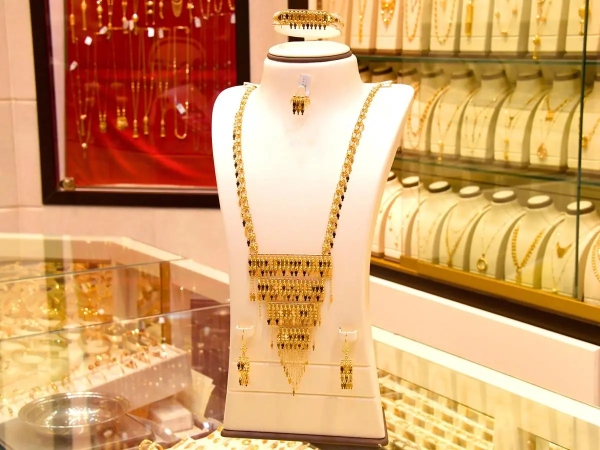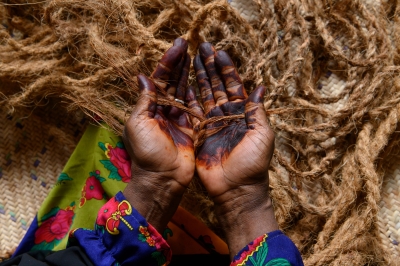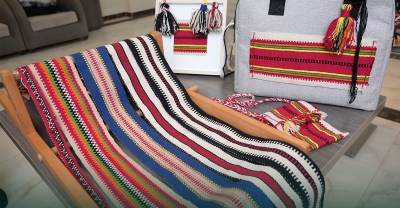

Jewelry Crafting in the Kingdom of Saudi Arabia is the art of crafting jewelry that varies across the Kingdom, with each region boasting unique features and styles in jewelry design.
Jewelry south of Saudi Arabia
In the southern regions of the Kingdom, traditional jewelry was primarily crafted from silver. They were characterized by their substantial size and limited use of gemstone settings in their embellishments. One distinctive feature of these jewelry was the decorative silver wires and plates added to their exterior surfaces. Beads and gemstones used in necklaces and other jewelry typically included fire agate beads from Yemen, amber, blood coral, and vintage-colored glass beads and parts.
Jewelry west of Saudi Arabia
A clear distinction can be observed between the jewelry of urban areas west of the Kingdom, such as Makkah al-Mukarramah, al-Madinah al-Munawwarah, and Jeddah, and that of the Bedouin communities. Bedouin jewelry was influenced by the styles of the southern part of the Kingdom along the Hejaz mountains to the north. Materials like leather and shells were added to the jewelry in the northern regions of the western part of the Kingdom.
Jewelry in western Saudi cities is influenced by welcoming pilgrims to the Grand Mosque and visitors to the Prophet’s Mosque from various peoples of the world each year. Some of these people bring their light and valuable handicrafts for trade, including jewelry not available in the sacred places and other nearby regions. This has led to the diversity and uniqueness of Hejazi jewelry compared to other regions.
Cities west of the Kingdom were also known for white gold (platinum), which was set with rare diamond gemstones. These materials adorned necklaces, bracelets, rings, and other items like the quivering brooches pinned onto bridal gowns. Platinum was also utilized in bridal crowns and groom accessories, among other items.
Jewelry east and north of Saudi Arabia
Jewelry in the eastern and northern regions of the Kingdom share similarities with those of Riyadh Province (central region) and some Gulf countries especially Bahrain, Kuwait, and Qatar, whether in their general characteristics, uses, or even sometimes in their names. This resemblance is attributed to social interaction and the migration of some people from the central region of the Kingdom to these regions.
Jewelry in the central region of Saudi Arabia (Najd)
There is little variation between the jewelry styles of urban and Bedouin communities in the central region of the Kingdom. Beaded necklaces were particularly prominent. In general, the jewelry is characterized by the use of turquoise (danaq or sharqi), pure (arghab) gold, silver, brass (safr), and gold-plated silver. Pearls were also used to enhance the jewelry, along with gemstones such as rubies and emeralds.
Deep red coral beads (ra‘af), amber in shades of red, yellow, light brown, and dark brown, as well as fire agate sourced from Yemen, were all utilized. These types of beads were commonly used in necklaces and pendants.
These gemstones, unavailable locally, were brought by traders from the central part of the Kingdom during their travels to Yemen for fire agate, to the Gulf and the Farasan Islands for pearls, and to Iran for turquoise, which was highly sought after for adorning jewelry.
The book, Lama’ al-Shihab, authored in 1818, describes the women of Najd: "They were adorned with an abundance of jewelry, including gold encrusted with precious gemstones such as rubies and others. Turquoise stones were particularly admired, and some would send emissaries to the King of Persia to purchase them."
Coral was brought from Egypt, as stated in the book Lama’ al-Shihab: "The people of Najd used to travel to Egypt, but they only purchased weapons and coral from there." Turquoise stones, especially in blue and green hues, were highly desired for adorning jewelry in Najd. The flat-surfaced ones, rather than the convex ones, were preferred. These stones were brought by traders who sold them to jewelers, and were highly valued.
Historical centers for jewelry crafting in the central region of the Kingdom included Diriyah, Sudayr, Buraydah, Unaizah, Hail, and Wadi ad-Dawasir. The book Lama’ al-Shihab further states: "Their craftsmanship in women’s jewelry cannot be measured by number because they go to great lengths, even the poor among them ensure their women have at least one gold jewelry. Wealthy individuals are eagerly seeking to acquire precious gemstones such as rubies, peridots, and turquoise, which are worn by their women."
Related quizzes
Related articles

